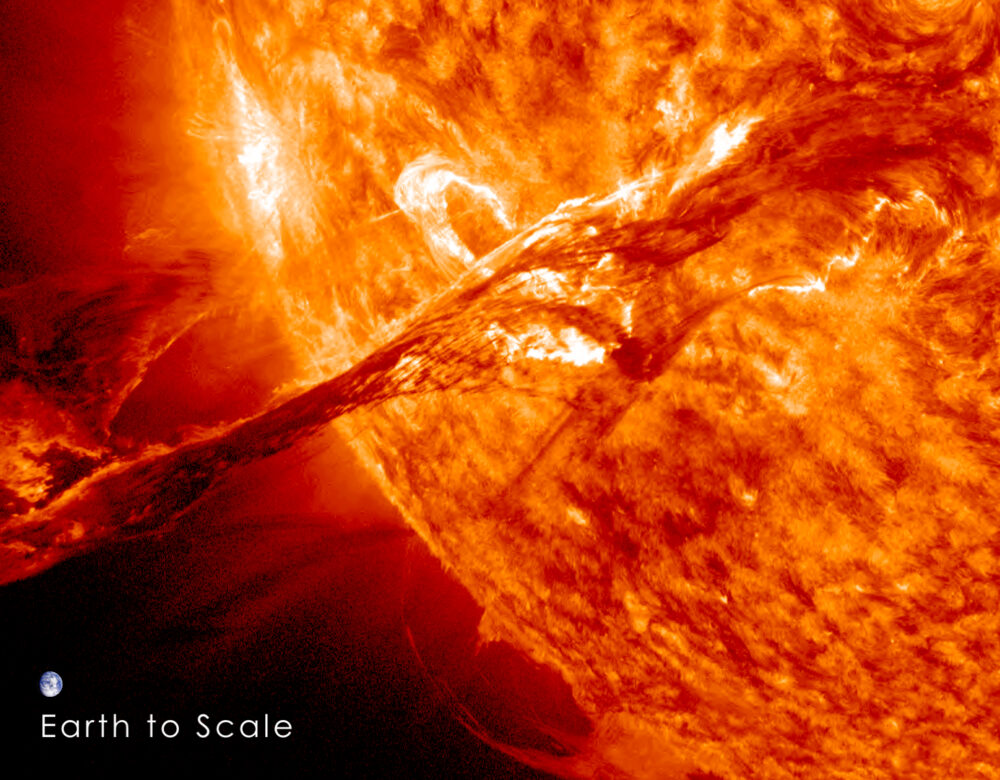In 2012 Fusa Miyake was a physics graduate student working on a project that involved traveling to a lush island in Southern Japan famous for its ancient cedar trees. She was doing a new type of carbon dating, and her findings created a buzz of excitement in archaeology and sent a frisson of fear through astronomers. But what do trees have to do with an event that could wreak havoc with satellites and power grids?
About The Disappearing Spoon
Hosted by New York Times best-selling author Sam Kean, The Disappearing Spoon tells little-known stories from our scientific past—from the shocking way the smallpox vaccine was transported around the world to why we don’t have a birth control pill for men. These topsy-turvy science tales, some of which have never made it into history books, are surprisingly powerful and insightful.
Credits
Host: Sam Kean
Senior Producer: Mariel Carr
Producer: Rigoberto Hernandez
Associate Producer: Sarah Kaplan
Audio Engineer: Rowhome Productions
Transcript
On March 13th, 1989, the Cold War seemed to take a dreadful turn. Around 2:45 am, people in Florida and Texas reported an eerie red glow in the sky. Simultaneously, a hiss of static interrupted Radio Free Europe, a station that promoted democracy behind the Iron Curtain.
Most drastically of all, the entire power grid of Quebec failed—crashing in just 90 seconds. Nine million people were plunged into darkness. Power grids in 200 other North American cities experienced hiccups as well.
People panicked. What was happening? Had the Soviet Union launched atomic bombs?
No. It turned out to just be a storm—although probably not the kind you’re thinking of. This storm began in outer space.
You might remember the solar storm that occurred last May. It produced Northern Light auroras as far south as Alabama. It was a fun moment. But that was a mild space storm. They can be vastly bigger—and more dangerous.
In 2019, the U.S. government’s Federal Emergency Management Agency released a report saying that only two natural threats could paralyze the entire nation at once. One was a pandemic. The other was a giant space storm. We all saw the havoc the pandemic wrought, but a giant space storm could be even worse.
As the son of a wealthy English brewer, Richard Carrington owned his own private astronomical observatory. He loved to while away the hours studying the sun.
He was especially intrigued by sunspots—patches of darkness on the solar surface. No one knew what sunspots were in his day. When Carrington sat down on September 1st, 1859, to examine some sunspots, he wasn’t expecting anything dramatic. But he noticed that there were a lot more sunspots than usual that day.
Suddenly, around noon, he saw something bizarre—an eruption. A giant geyser of plasma just leapt right off the surface of the sun. After a moment’s bewilderment, Carrington jotted down some notes, unsure what to make of what he’d just witnessed.
We now call these eruptions solar flares, and Carrington was the first person in history to see one. But what makes the event truly special—and what frightens scientists about solar flares today—is what happened next.
That night, people noticed that compasses were not working properly; the needles wobbled, or no longer pointed north. Unusually vivid auroras appeared in the heavens, too. And not just at high latitudes: the Northern Lights appeared as far south as Venezuela.
In the northeast United States, people could read newspapers outdoors well past midnight. In the Rocky Mountains, the vivid sky set birds chirping. Dozens of grumbling goldminers rolled out of bed and started making breakfast, assuming it was dawn.
Telegraph systems went haywire as well. Some operators got electric shocks, and several telegraph offices started on fire. Some operators disconnected their machines from the batteries—and the machines still worked. One duo in Boston and Maine held a two-hour telegraph conversation with no power source. Spookiest of all, some telegraphs started spewing out gibberish without anyone touching them. They seemed possessed.
It was the strangest night anyone could remember. And as these stories trickled back to astronomer Richard Carrington, he immediately thought back to the solar flare he’d seen. Could there be a connection?
We know now his hunch was right. That solar flare was part of a larger event called a solar storm. And it was responsible for every one of those bizarre events.
During a solar storm, a few related things can happen. First, there’s a burst of radiation: gamma rays, x-rays, things like that. Second, there’s a burst of particles, mostly electrons and protons.
Scientists don’t know exactly what causes solar storms, but they have linked them to the sun’s magnetic field.
The sun consists mostly of plasma. That’s a scorching-hot state of matter. So hot that atoms separate into charged particles. It’s a boiling soup of ions.
Now, charged particles in motion always create magnetic fields. And our sun happens to rotate, just like Earth does. So, this rotational motion of charged particles inevitably produces a magnetic field.
But the sun’s magnetic field is not stable. A few years after seeing the solar flare, Richard Carrington made an important discovery about the sun’s rotation. The sun is a fluid body, not solid. And by tracking the movement of sunspots over time, Carrington noticed that different parts of the sun rotate at different speeds. Specifically, the solar equator rotates once every 25 days. The sluggish poles take 33.
The upshot is that different patches of charged, magnetic field–generating plasma are swirling around at different rates. This causes energy and tension to build up in complicated ways. It’s similar to a buildup of static electricity. And every so often—boom! All the extra energy erupts at once in geysers of radiation and particles.
The radiation moves at the speed of light, and it arrives at Earth in eight minutes. The particles take longer. The burst that Carrington saw took 17½ hours to arrive. But given that the distance to the sun is 93 million miles, that’s still moving pretty fast—five million miles per hour.
Now, when those particles reached Earth, several things happened. For one thing, Earth’s own magnetic field will deflect those incoming particles and channel them toward the poles. After reaching the poles, the particles zip down towards Earth’s surface. And on the way, they collide with nitrogen and oxygen molecules in the air. These collisions produce the psychedelic greens, blues, purples, and reds of the Northern and Southern Lights.
That’s why auroras usually appear only at high latitudes—because Earth’s magnetic field channels incoming particles there. However, massive solar storms release so many particles at once that the auroras extend much farther toward the equator. That’s why people in Venezuela could see the auroras in 1859, and why birds started chirping and woke up gold miners at 3am.
The second major effect of a solar storm involves a distortion of Earth’s magnetic field. You can think of our planet’s magnetic field as a series of curved lines. They loop around Earth from pole to pole. Think back on that grade-school experiment where you placed a bar magnet beneath a sheet of cardboard. Then you sprinkled iron filings on top. The filings arranged themselves into similar loops.
During a solar storm, the incoming blizzard of particles produces a shockwave. And this shockwave effectively “squashes” Earth’s magnetic field lines together. It sounds strange, but that’s what happens. This squashing of Earth’s magnetic field is called a geomagnetic storm.
These geomagnetic storms do odd things. They can bamboozle pigeons and other creatures that use Earth’s magnetic field to navigate. The storms can also set off magnetically triggered mines. This actually happened during the Vietnam War. A solar storm set off four thousand magnetic mines at once.
On a global scale, geomagnetic storms generate electricity. As mentioned, charged particles in motion create magnetic fields. The inverse is also true: Magnetic fields that are put into motion create electric currents in any matter that’s nearby. During geomagnetic storms, the squashing of Earth’s magnetic field produces electrical currents within Earth itself. This causes electricity to build up in the ground.
That explains all those strange things that happened with telegraph wires in 1859. Electricity from the ground was rushing up through poorly grounded electrical equipment. That’s why telegraph operators got shocked, and why they could hold conversations without batteries. Earth itself was powering their equipment.
And it’s not just telegraph lines. The electricity created during geomagnetic storms can course through anything metal: pipes, railroad tracks, powerlines. In fact, that’s what happened in Quebec on March 13th, 1989. A solar storm squashed the Earth’s magnetic field. And the electricity that this produced surged into power lines all over Quebec. This tripped a bunch of circuit breakers, and a cascade of failures took down the whole power grid in just 90 seconds.
And frankly, things could have been a lot worse. The 1989 flare was not very big compared to the 1859 Carrington Event. Had the Carrington Event happened in 1989, the entire North American power grid could have gone down.
Satellites are even more vulnerable to solar storms. They’re just floating up in space, totally exposed. The influx of particles can flip bits in a satellite’s memory and scramble it. The particles can also cause a satellite to send out spurious signals. Or they can straight-up fry its electronics.
That’s why solar storms are dangerous. If satellites or the power grid went down, that would throw society into chaos. Most phones and communications equipment would no longer work. People would be floundering without information. The loss of power would be especially harrowing. It would disrupt our ability to distribute food, to cool and heat our homes, to provide medical care. We wouldn’t recover for weeks—perhaps months. Many people could die.
And the really scary thing is that the 1859 Carrington event is itself small potatoes compared to truly epic solar storms that scientists have recently discovered.
In 2012, a physics graduate student in Japan named Fusa Miyake started a new project. She traveled to a lush island in southern Japan that was famous for its ancient cedar trees. Some were nearly 1900 years old.
Miyake found the stump of one ancient cedar tree and removed a slice. Her project involved looking for carbon-14 in tree rings.
Carbon-14 forms in Earth’s upper atmosphere when particles from space collide with nitrogen atoms there. Then the carbon-14 joins with oxygen molecules to form carbon dioxide. The carbon dioxide trickles toward the ground and gets incorporated into plants, and then the animals that eat plants. As a result, every living thing on earth has some carbon-14 in it.
Now, carbon-14 is mildly radioactive. And once something dies, it no longer brings new carbon-14 into its body. So scientists can take old organic matter, like ancient timber, and determine its precise age based on the amount of carbon-14 that remains. This process is called carbon-dating.
Carbon-dating has been around since the 1950s. But Fusa Miyake in Japan was trying out a novel type of carbon-dating. Most plants take in carbon-14 and distribute it all over their bodies. Trees do something a little different. Trees add a growth ring each year, about a millimeter wide. So any carbon-14 inside a given ring must have come from the atmosphere that same year.
Prior to Miyake, no one had measured carbon-14 levels in individual tree rings before. That’s because the amount of wood in each ring was so tiny. But by using a new, highly sensitive technique, Miyake succeeded in getting solid readings.
And she found something interesting. In her ancient cedar rings, she saw spikes of carbon-14 during certain years. One spike occurred in 774 A.D., another in 993 A.D. These spikes are now called Miyake events. Scientists don’t know exactly what causes them, but solar storms are a leading candidate.
And while Miyake was a physicist, her work caused an immediate buzz of excitement in another field—archaeology.
You see, it’s often hard to date things precisely in archaeology. You can often narrow the date down to maybe a half century, or a quarter century. But that’s it. One archaeologist has said that if the two world wars had taken place in 1914 B.C. and 1939 B.C., we wouldn’t be able to tell them apart today in the historical record. That’s a bit embarrassing.
But Miyake events provide a way around this limitation—a way to date things precisely.
For example, archaeologists have known for years that the Vikings landed in Newfoundland in North America sometime around the year 1000. But we couldn’t narrow it down beyond that.
Well, two archaeologists heard about Miyake’s work and got inspired. They dug up some timber that the Vikings had used to make a longhouse in North America. Then they copied Miyake’s work. They started measuring the carbon-14 levels in the logs ring by ring.
Most rings had normal carbon-14 activity. Nothing special. One ring, however, showed a spike—a crackle of radioactivity. It was the Miyake event from the year 993.
And once they’d pinpointed that ring, the archaeologists simply had to count the number of rings out to the edge of the tree. One, two, three, four … all the way to 28. That meant the Vikings cut down that tree to make their longhouse 28 years after 993. In other words, they landed in the year 1021. Pretty nifty.
And that’s just the start. Believe it or not, archaeologists have no firm idea when the first pyramids in Egypt were built. They also don’t know how the ancient Mayan and Aztec calendars line up with our Gregorian calendars, among dozens of other mysteries. But if they can find wooden artifacts from those sites, the Miyake events recorded in the tree rings could serve as a “cosmic timestamp” to nail the dates down. It could revolutionize archaeology.
But however exciting, Miyake events are also a little scary. Because if Mikaye events did result from solar storms, they were truly massive storms—with the potential to cause equally massive damage.
Here are some numbers for perspective. The atomic bomb that leveled Hiroshima in 1945 released the energetic equivalent of 15,000 tons of TNT. Well, the Carrington Event of 1859 released the equivalent of 660 billion Hiroshima bombs.
And the Miyake events of 774 and 993 were five times bigger than the Carrington Event. Scientists now know of an event from 14,300 years ago that was twice as big as those. We’re talking 6.7 trillion Hiroshima bombs.
Can you imagine what that would do to our power grid and satellites? Nothing good.
For this reason, scientists are currently scrambling to understand solar storms, especially what causes them. Some of these researchers call themselves “space-weather forecasters.” The most important thing they want to know is whether we can predict solar storms. Are there any warning signs?
We know that the presence of sunspots will boost the chances of a solar storm. But the correlation isn’t very strong. Other clues or insights are necessary. And the stakes could not be higher. If we don’t figure this out, the consequences for our civilization could be catastrophic.
Down here on Earth, the appearance of sunshine often marks the end of a stormy period, both meteorologically and metaphorically. Here comes the sun, and all that. But that sense of peace and tranquility is an illusion. Our solar system is a volatile place. And when the sun gets ornery, it can unleash vicious storms of its own—the likes of which we should pray we never see again.




